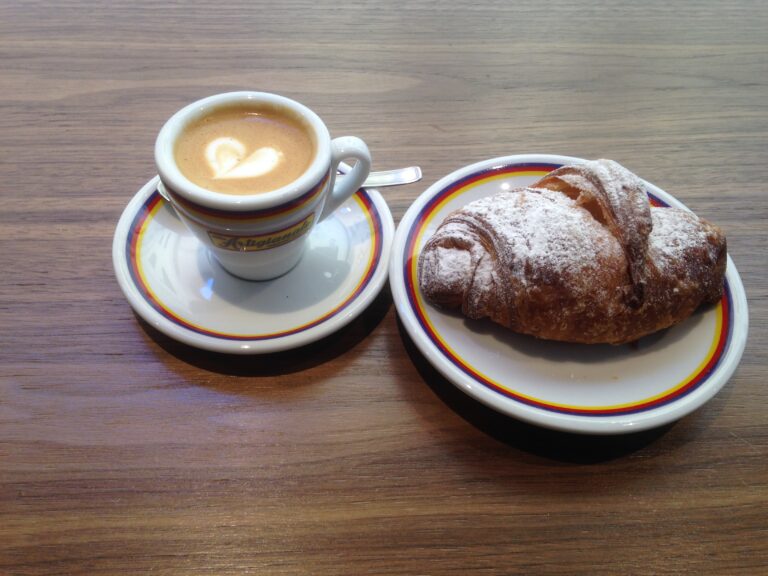☕ La Colazione Italiana: A Simple, Sweet, and Irresistible Start to the Day
In Italy, mornings begin not with a feast, but with a ritual of flavor and finesse. La colazione is light, elegant, and deeply satisfying. Italians don’t rush breakfast—they savor it. Every sip and bite celebrates simplicity, quality, and joy.
🌅 A Philosophy of Flavor: Less Is More
Rather than overwhelming the table, Italians focus on a few perfect elements. This minimalist approach highlights quality over quantity. Whether at home or standing at the bar, breakfast becomes a moment of pleasure before the day unfolds.
☕ Coffee: The Heartbeat of the Italian Morning
Coffee isn’t just a beverage—it’s a cultural cornerstone.
- Italians start their day with a bold espresso, rich and aromatic. It delivers a quick, energizing kick.
- However, the true morning star is the cappuccino. This dreamy blend of espresso, steamed milk, and airy foam is a morning-only indulgence. After 11 AM, it’s considered taboo.
- For those who prefer a gentler touch, the caffè latte offers a creamier, more comforting experience.
At the bar, the hiss of the espresso machine and the clink of porcelain cups create a symphony of anticipation. Meanwhile, the aroma of freshly brewed coffee fills the air, inviting you to pause and enjoy.
🥐 Pastries: A Showcase of Italian Pasticceria
Step into any pasticceria, and you’ll be greeted by a display that’s nothing short of edible art.
- The cornetto, Italy’s answer to the croissant, is golden, flaky, and often filled with jam, custard, chocolate, or honey. It’s the undisputed breakfast favorite.
- Slightly softer and sweeter, the brioche melts in your mouth. Some are topped with sugar crystals or almonds, adding texture and indulgence.
- For a crunchier bite, fette biscottate—twice-baked bread slices—are perfect with butter, jam, or a generous swipe of Nutella.
Not only do these pastries satisfy your sweet tooth, but they also pair beautifully with a warm cappuccino, creating a harmonious start to the day.
🍞 Bread and Spreads: Rustic Comfort
Sometimes, simplicity wins.
- Pane e marmellata—fresh bread with butter and jam—is a timeless choice.
- Nutella, beloved across generations, turns even the humblest slice into a treat.
In addition to their comforting flavors, these options evoke cozy kitchens and childhood mornings.
🍓 Yogurt, Fruit, and Juice: Light and Refreshing
For a healthier twist, Italians often include:
- Yogurt, plain or sweetened with honey.
- Seasonal fruit, fresh and vibrant, offering a burst of natural sweetness.
- Occasionally, a glass of freshly squeezed juice adds a citrusy kick to the morning.
Together, these additions balance indulgence with nourishment, making breakfast both satisfying and wholesome.
🏠 Home vs. Bar: Two Ways to Savor the Morning
At home, breakfast is quick and practical—coffee, a pastry, and out the door. Yet many Italians prefer the charm of the bar.
- Locals stand at the counter, sip espresso or cappuccino, and enjoy a warm cornetto.
- The bar becomes a social hub—a place to chat, read the paper, or simply pause before the day begins.
In contrast to the solitude of home, the bar offers connection, community, and a shared love for good coffee.
📍 Regional Flavors: A Taste of Local Identity
Each region adds its own twist:
- In Northern Italy, dairy plays a bigger role—think yogurt, cheese, and buttery pastries.
- In Central Italy, rustic bread with honey or jam is common. Sometimes, even a slice of homemade cake appears.
- In Southern Italy, expect sweeter pastries and stronger coffee. The flavors are bold, vibrant, and unforgettable.
📍 Regional Flavors: A Taste of Local Identity
Each region adds its own twist:
- In Northern Italy, dairy plays a bigger role—think yogurt, cheese, and buttery pastries.
- In Central Italy, rustic bread with honey or jam is common. Sometimes, even a slice of homemade cake appears.
- In Southern Italy, expect sweeter pastries and stronger coffee. The flavors are bold, vibrant, and unforgettable.
As you travel.
As you travel through Italy, breakfast through Italy, breakfast becomes a delicious reflection of local becomes a delicious reflection of local culture.
✨ Conclusion: A Breakfast That Captures the Italian culture.
✨ Conclusion: A Breakfast That Captures the Italian Soul
Ultimately, *la colazione italiana Soul
Ultimately, la colazione italiana is more than a meal—it’s a moment of joy. From the* is more than a meal—it’s a moment of joy. From the velvety foam of a cappuccino to the golden layers velvety foam of a cappuccino to the golden layers of a cornetto, every of a cornetto, every element is crafted to delight.
Whether you’re sipping coffee at a bustling bar or enjoying a quiet element is crafted to delight.
Whether you’re sipping coffee at a bustling bar or enjoying a quiet morning at home morning at home, Italian breakfast invites you to slow down, savor the flavors, and start, Italian breakfast invites you to slow down, savor the flavors, and start your day with a smile.

